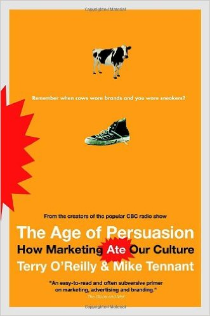Nick Pateras | The Age of Persuasion
BOOK REVIEW
The Age of Persuasion: How Marketing Ate Our Culture – Terry O’Reilly & Mike Tennant
Experienced ad men lead a fun-filled ride through the omnipresent force that is advertising
Regular listeners of CBC may recognize the title of this book and its authors, as they co-hosted a hugely popular weekly radio show by the same name for several years, offering people who tuned in an insight into the enigmatic world of advertising. (The show has since been rebranded as Under The Influence.) This book is an extension of that production, guiding those outside the marketing world through a tour of its history and its rapid proliferation throughout the 20th century. Each chapter is laden with examples, many of which were intriguing enough for me to research on my own, especially as several were presented in the context of revolutionary industry thought. For instance, in exemplifying the depth of advertising’s penetration, the authors presented the intriguing case of San Diego teacher Tom Fabler, who went so far as to sell ad space on his students’ tests.
Obviously I picked up this book to develop more knowledge about the industry in which I am now engrossed and it certainly didn’t disappoint. Not only did I learn about massively important evolutionary points in advertising’s chronology – such as John Kennedy’s now legendary proclamation in 1904 that advertising should be regarded as ‘salesmanship on paper’ – I also absorbed the fundamental themes that hold true in today’s hyper-competitive marketing world.
"Honoring the contract begins with an understanding that every ad, no matter how entertaining, is an interruption."
As expected, the book certainly glorifies the advertising realm in similar fashion to Mad Men (less the drinking and adultery) in discussing its ability to influence, but it must be said that the authors do possess the modesty to concede that in actuality advertising mirrors societal thinking rather than driving it. This would be a comfortable and intriguing read for anyone on the outside looking in but may be somewhat banal for those with industry experience. I loved many of the referenced examples but as a brand marketer was hoping for more analysis as to the business insights that drove some of the major creative decisions. Having said that, its thoroughness cannot be understated and it really illustrates well how advertising has come to establish itself as a ubiquitous necessity in the contemporary period.
-NP, Dec. 2013
